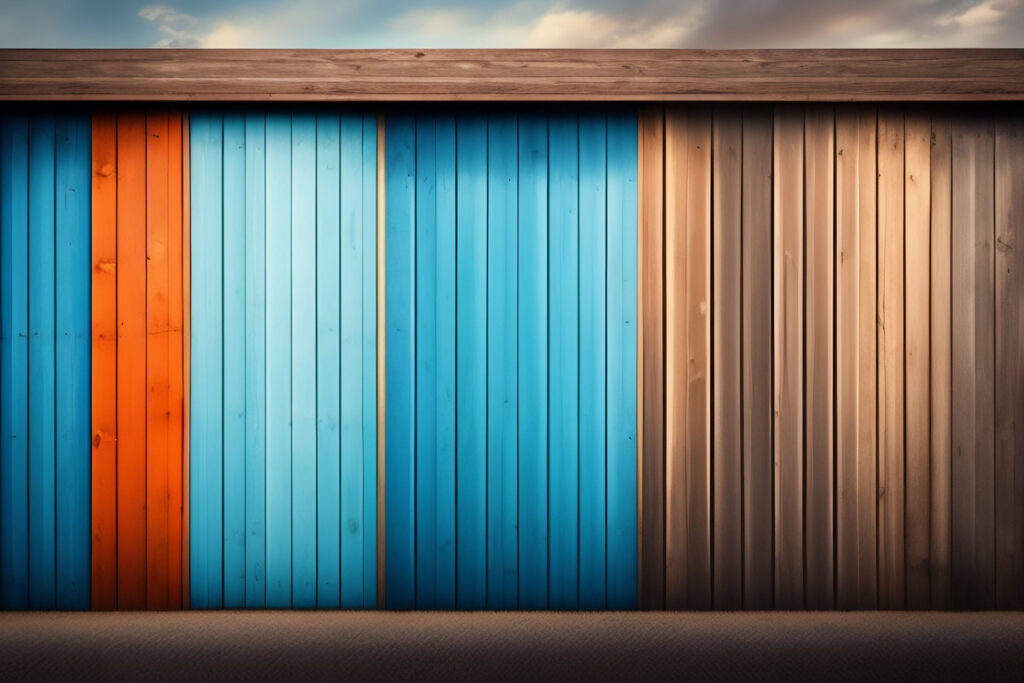Don’t you feel good each time you see a rainbow in the sky? The combination of different colors is a visual delight that makes everyone happy.
Unfortunately, rainbow colors are not exactly a practical choice when it comes to barns.
Choosing the right color for your steel barn is more than a design decision. It is an opportunity to enhance the aesthetic appeal and the long-term durability of the structure. A barn’s color can influence how well it blends with its surroundings, how effectively it regulates temperature, and how much maintenance it requires over time.
If you are building a barn for agricultural purposes, or livestock housing, storage, or other uses, then choosing the ideal color is an essential step in the process.
In this comprehensive guide, we will explore the various factors to consider when choosing a color for your steel barn, the benefits of specific hues, and how to ensure your barn complements your property while meeting practical requirements.
Why Color Choice Matters
Choosing the right color for your steel barn goes beyond mere aesthetics; it plays a vital role in functionality, energy efficiency, and long-term maintenance. The color you select can influence how well your barn integrates with its surroundings, reflecting your property’s overall style. Additionally, the choice of color affects how much heat your barn absorbs or reflects, impacting interior temperature and energy costs. Moreover, color selection can determine how well the barn conceals wear and tear, such as dirt or fading, over time. These factors highlight why careful consideration of color is essential when designing or upgrading your steel barn.
- Aesthetic Harmony
The color of your steel barn significantly impacts its visual presence on your property. A well-chosen hue can enhance curb appeal, creating a cohesive look that ties the barn to the surrounding landscape or nearby structures. Neutral tones blend effortlessly with rural environments, while bolder shades can create striking contrasts and draw attention to your barn. - Functionality and Energy Efficiency
Color influences how much heat a barn absorbs or reflects. Lighter colors, like white or light gray, reflect sunlight, helping to keep the interior cooler in warm climates. Darker tones, such as black or deep red, absorb heat, making them a better choice for colder regions where maintaining warmth is a priority. - Maintenance and Longevity
Different colors may show wear differently over time. Neutral and earthy tones are less likely to show dirt, scratches, or fading, while bold or dark colors may require more frequent upkeep to maintain their vibrancy. High-quality paints and finishes can mitigate these concerns, ensuring your barn remains attractive and functional for years.
Factors to Consider When Choosing a Color
- Climate and Weather Conditions
Your local climate should heavily influence your choice of color. In sunny or hot regions, light colors like beige, white, or pastel shades are ideal for reflecting sunlight and minimizing heat buildup. Conversely, if you live in a colder area, darker colors like navy blue, forest green, or even black can help retain warmth inside the barn. - Surrounding Landscape
Think about how the barn will fit into its environment. A barn located in a wooded area might look best in earthy tones like brown or green, while a barn on an open plain could stand out beautifully in red or blue. Consider whether you want your barn to blend in or stand out as a focal point. - Purpose of the Barn
The barn’s intended use can guide your color decision. A barn used primarily for livestock may benefit from lighter colors that reduce heat buildup, ensuring the animals’ comfort. Storage barns for equipment or vehicles might prioritize darker colors that hide dirt and grime. - Branding and Personal Preference
If your barn is part of a business, color can reflect your brand identity. For instance, a farm focusing on organic produce might choose green to symbolize sustainability. On a personal level, the color of your home or other buildings on your property can help guide your choice for a cohesive aesthetic.
Popular Color Choices for Steel Barns
When it comes to steel barns, popular color choices often balance practicality with aesthetics, ensuring the structure is both functional and visually appealing. Classic red remains a timeless favorite. Neutral tones like white and gray provide a clean and versatile look, ideal for modern barns and hot climates due to their reflective properties. Earthy shades such as brown and green create harmony with the environment. For a bold and contemporary touch, black and blue barns deliver striking visual statements.
Classic Red
The quintessential barn color, red, has a long history rooted in practicality. Early farmers used red paint because it was affordable and durable, thanks to the inclusion of iron oxide, which helped protect wooden structures. Today, red steel barns evoke nostalgia while providing a vibrant, eye-catching look. They are particularly striking against green pastures or snow-covered landscapes.
Neutral White and Gray
White and gray are versatile options that offer a clean, modern appearance. These colors reflect sunlight effectively, making them an excellent choice for hot climates. They also pair well with contrasting trim colors, such as black or blue, for added visual interest.
Earthy Brown and Green
Brown and green barns blend seamlessly with natural surroundings, making them ideal for rural settings. Brown tones mimic the appearance of wood, offering a traditional look, while green hues symbolize eco-friendliness and complement lush landscapes.
Bold Black and Blue
Black barns exude sophistication and are becoming increasingly popular for modern properties. While black absorbs heat, it offers a sleek and minimalist aesthetic. Blue barns, ranging from light sky blue to deep navy, provide a versatile and calming presence, suitable for various environments.
Custom Colors
Many manufacturers offer custom color options, allowing you to create a unique look tailored to your property. Customization opens up endless possibilities, from matching your barn to your home’s color scheme to incorporating bold and unconventional hues.
The Role of Trim and Accent Colors
The main color of your steel barn sets the foundation for its appearance, but trim and accent colors can take its design to the next level. Contrasting trims—such as white trim on a red barn or black trim on a gray barn—add depth and visual appeal. Decorative accents like doors, windows, and roof panels can also be painted in complementary colors to create a cohesive and attractive design.
When selecting trim and accent colors, consider how they interact with the primary color and whether they align with the surrounding environment or your personal style.
How Color Impacts Functionality
- Temperature Regulation
As mentioned earlier, color plays a crucial role in temperature control. Light-colored barns reflect heat, keeping interiors cool, while darker barns absorb heat to maintain warmth. This functionality is especially important for barns used to house animals or store temperature-sensitive items. - Visibility and Safety
Bright colors, such as red or orange, can increase visibility, making the barn easier to spot from a distance. This is particularly useful in expansive properties or areas with low visibility due to weather conditions. - Maintenance and Cleaning
Certain colors are better at hiding dirt, scratches, and wear. For example, gray and brown tones are excellent at concealing imperfections, while lighter colors like white may show dirt more readily. Opting for a low-maintenance color can save time and effort in the long run.
Choosing the Right Paint and Finish
Durability and Resistance
High-quality paint designed for metal surfaces is essential to ensure your barn can withstand weather, UV rays, and other environmental factors. Look for paints with rust inhibitors and fade resistance to maintain the barn’s appearance and structural integrity.
Powder Coating
Powder-coated finishes are a popular choice for steel barns due to their durability and low maintenance. These finishes resist chipping, scratching, and fading, ensuring the barn remains in excellent condition.
Gloss vs. Matte Finishes
Glossy finishes provide a polished and shiny look that’s easy to clean, while matte finishes offer a more subdued and natural appearance. Consider the aesthetic you want to achieve and the practicality of maintaining the finish.
Tips for Selecting the Perfect Color
- Visualize the Options
Many manufacturers provide digital tools or samples that allow you to see how different colors will look on your steel barn. Take advantage of these tools to explore combinations and find the best match. - Think Long-Term
Consider how the color will age over time. Neutral and earthy tones tend to weather gracefully, while bold colors may require more maintenance to retain their vibrancy. - Match the Environment
Ensure the barn complements its surroundings and existing structures on your property. A harmonious color scheme enhances the overall aesthetic appeal of your property. - Consult Professionals
If you’re unsure about your decision, seek advice from manufacturers or design experts. They can provide valuable insights based on your specific needs and preferences.
Conclusion
The color of your steel barn is a reflection of your style, needs, and the environment it resides in. Whether you opt for a classic red barn, a sleek black design, or a custom hue tailored to your property, the right color can elevate the barn’s functionality and visual appeal. Take the time to evaluate your options, consider the long-term impact, and prioritize high-quality finishes to ensure your steel barn remains a durable and attractive feature for years to come.

